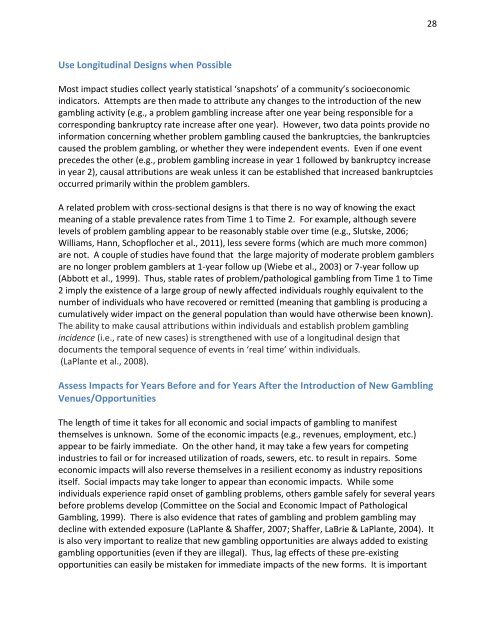gambling in alberta - Research Services - University of Lethbridge
gambling in alberta - Research Services - University of Lethbridge
gambling in alberta - Research Services - University of Lethbridge
You also want an ePaper? Increase the reach of your titles
YUMPU automatically turns print PDFs into web optimized ePapers that Google loves.
Use Longitud<strong>in</strong>al Designs when Possible<br />
Most impact studies collect yearly statistical ‘snapshots’ <strong>of</strong> a community’s socioeconomic<br />
<strong>in</strong>dicators. Attempts are then made to attribute any changes to the <strong>in</strong>troduction <strong>of</strong> the new<br />
<strong>gambl<strong>in</strong>g</strong> activity (e.g., a problem <strong>gambl<strong>in</strong>g</strong> <strong>in</strong>crease after one year be<strong>in</strong>g responsible for a<br />
correspond<strong>in</strong>g bankruptcy rate <strong>in</strong>crease after one year). However, two data po<strong>in</strong>ts provide no<br />
<strong>in</strong>formation concern<strong>in</strong>g whether problem <strong>gambl<strong>in</strong>g</strong> caused the bankruptcies, the bankruptcies<br />
caused the problem <strong>gambl<strong>in</strong>g</strong>, or whether they were <strong>in</strong>dependent events. Even if one event<br />
precedes the other (e.g., problem <strong>gambl<strong>in</strong>g</strong> <strong>in</strong>crease <strong>in</strong> year 1 followed by bankruptcy <strong>in</strong>crease<br />
<strong>in</strong> year 2), causal attributions are weak unless it can be established that <strong>in</strong>creased bankruptcies<br />
occurred primarily with<strong>in</strong> the problem gamblers.<br />
A related problem with cross-sectional designs is that there is no way <strong>of</strong> know<strong>in</strong>g the exact<br />
mean<strong>in</strong>g <strong>of</strong> a stable prevalence rates from Time 1 to Time 2. For example, although severe<br />
levels <strong>of</strong> problem <strong>gambl<strong>in</strong>g</strong> appear to be reasonably stable over time (e.g., Slutske, 2006;<br />
Williams, Hann, Schopflocher et al., 2011), less severe forms (which are much more common)<br />
are not. A couple <strong>of</strong> studies have found that the large majority <strong>of</strong> moderate problem gamblers<br />
are no longer problem gamblers at 1-year follow up (Wiebe et al., 2003) or 7-year follow up<br />
(Abbott et al., 1999). Thus, stable rates <strong>of</strong> problem/pathological <strong>gambl<strong>in</strong>g</strong> from Time 1 to Time<br />
2 imply the existence <strong>of</strong> a large group <strong>of</strong> newly affected <strong>in</strong>dividuals roughly equivalent to the<br />
number <strong>of</strong> <strong>in</strong>dividuals who have recovered or remitted (mean<strong>in</strong>g that <strong>gambl<strong>in</strong>g</strong> is produc<strong>in</strong>g a<br />
cumulatively wider impact on the general population than would have otherwise been known).<br />
The ability to make causal attributions with<strong>in</strong> <strong>in</strong>dividuals and establish problem <strong>gambl<strong>in</strong>g</strong><br />
<strong>in</strong>cidence (i.e., rate <strong>of</strong> new cases) is strengthened with use <strong>of</strong> a longitud<strong>in</strong>al design that<br />
documents the temporal sequence <strong>of</strong> events <strong>in</strong> ‘real time’ with<strong>in</strong> <strong>in</strong>dividuals.<br />
(LaPlante et al., 2008).<br />
Assess Impacts for Years Before and for Years After the Introduction <strong>of</strong> New Gambl<strong>in</strong>g<br />
Venues/Opportunities<br />
The length <strong>of</strong> time it takes for all economic and social impacts <strong>of</strong> <strong>gambl<strong>in</strong>g</strong> to manifest<br />
themselves is unknown. Some <strong>of</strong> the economic impacts (e.g., revenues, employment, etc.)<br />
appear to be fairly immediate. On the other hand, it may take a few years for compet<strong>in</strong>g<br />
<strong>in</strong>dustries to fail or for <strong>in</strong>creased utilization <strong>of</strong> roads, sewers, etc. to result <strong>in</strong> repairs. Some<br />
economic impacts will also reverse themselves <strong>in</strong> a resilient economy as <strong>in</strong>dustry repositions<br />
itself. Social impacts may take longer to appear than economic impacts. While some<br />
<strong>in</strong>dividuals experience rapid onset <strong>of</strong> <strong>gambl<strong>in</strong>g</strong> problems, others gamble safely for several years<br />
before problems develop (Committee on the Social and Economic Impact <strong>of</strong> Pathological<br />
Gambl<strong>in</strong>g, 1999). There is also evidence that rates <strong>of</strong> <strong>gambl<strong>in</strong>g</strong> and problem <strong>gambl<strong>in</strong>g</strong> may<br />
decl<strong>in</strong>e with extended exposure (LaPlante & Shaffer, 2007; Shaffer, LaBrie & LaPlante, 2004). It<br />
is also very important to realize that new <strong>gambl<strong>in</strong>g</strong> opportunities are always added to exist<strong>in</strong>g<br />
<strong>gambl<strong>in</strong>g</strong> opportunities (even if they are illegal). Thus, lag effects <strong>of</strong> these pre-exist<strong>in</strong>g<br />
opportunities can easily be mistaken for immediate impacts <strong>of</strong> the new forms. It is important<br />
28
















